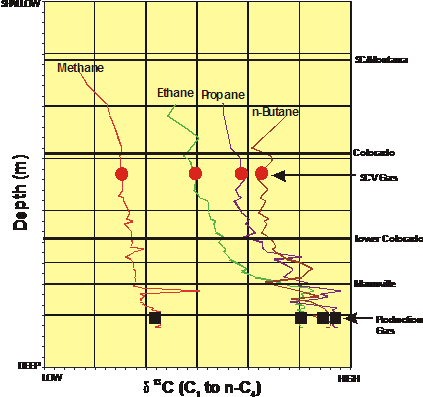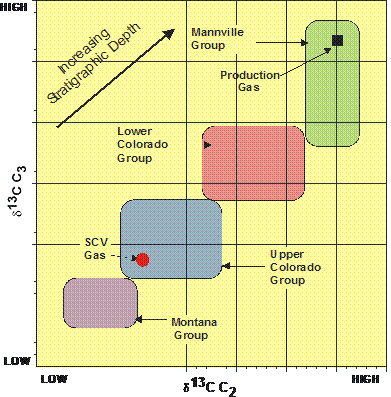Subsurface Isotope Template
Natural Gas Isotope Logs (NGIL) developed by GCHEM provide the information necessary to develop a template for the distribution of isotopic compositions of hydrocarbons in subsurface geological formations. Because the isotopic composition of natural gases, including methane, ethane, propane and butane, among other molecules, varies systematically with depth, hydrocarbons originating within individual geological units can have unique, or diagnostic, isotopic compositions. A NGIL records local isotopic and molecular variations through collection of mud gas samples using specialized sampling methods and analyses by gas chromatography and isotope ratio mass spectrometry.
Example of Natural Gas Isotope Log showing subsurface depth variations in carbon isotopic composition of C1 through C4 n-alkanes (methane, ethane, propane, and n-butane).

Isotope Gas Field Diagram
Geochemical data obtained from the NGIL may be used to construct an Isotopic Gas Field Diagram. These diagrams are particularly useful for identifying potential zones of leakage of natural gas. One area of application is in the remediation of active gas migration, or leakage of gases around existing well bores. By comparing the isotopic composition of the fugitive gases to the template derived from the NGIL, the source zone can be more accurately identified than through more conventional logging methods such as temperature or acoustic. In some areas, remediation efforts utilizing interpretation of isotopic data by GCHEM have increased from success rates of 15% to more than 80% resulting in tremendous time and money savings.
Collection Techniques
To construct a NGIL specialized sampling equipment and techniques are applied by GCHEM at the well site during drilling. High-Flow Constant-Volume mud traps are installed in the suction tank prior to drilling fluid being circulated down hole and in the shale shaker. A sampling manifold collects multiple gas samples at lag corrected depths at client specified intervals (recommended 3 to 5m or less in tight shale-gas prone areas). Gas samples are subsequently analyzed by GCHEM for molecular and isotopic compositions using our in-house equipment.

